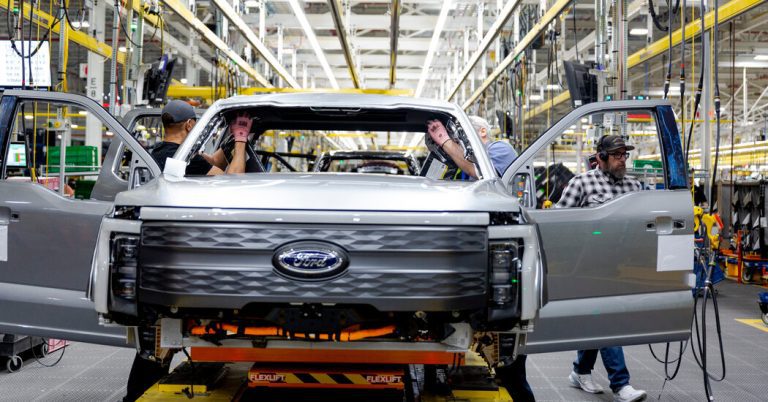Ford Motor Co. on Thursday delayed production of at least two new electric cars and said it would shift to making more hybrids. Its decision was the latest sign that major automakers have been forced to rethink their strategy for electric vehicles as sales for those models slow.
The shift by Ford and automakers such as General Motors and Mercedes-Benz, which have also pushed back their electric car plans, was largely driven by the companies’ difficulties in building and selling enough electric cars and doing so profitably. .
Sales of such vehicles are still growing, but the pace has slowed sharply in recent months as automakers have taken advantage of many of the early adopters willing to spend more than $50,000 for a new battery-powered car. Because they’re still learning how to make their cars and batteries at lower costs, companies haven’t been able to showcase more affordable models.
“A lot of companies rushed in too quickly with EVs that were too expensive and there wasn’t as big a market for them as they thought,” said Sam Abuelsamid, principal transportation and mobility analyst at research firm Guidehouse Insights. “That made it much more difficult to sell these vehicles.”
Some consumers are also reluctant to buy electric models because they can’t charge the vehicles at home or worry that there won’t be enough public chargers available when they want to travel more than a few hundred miles.
Many car buyers interested in electric vehicles seem to be opting for hybrid cars, which can cost just a few hundred dollars more than comparable gas-only models and in some cases offer much better fuel economy. These cars are also easier for consumers to get used to because they don’t need to be plugged in and are powered like conventional models.
Andy Goodrich, a retired software engineer in Ann Arbor, Mich., considered buying a Tesla Model 3 or a Rivian sport-utility vehicle, but had concerns about finding charging stations. Ultimately, he chose a Toyota RAV4 Prime plug-in hybrid, which can travel about 40 miles on electric power alone before switching to a gas engine.
“I do most of my driving locally, so I can go a week or more without using gas,” Mr. Goodrich, 72, said. “I charge in my garage overnight and I’m ready for the day. If I have to go to Grand Rapids or something, then the gas engine takes me there.”
Ford said Thursday it hoped to offer a hybrid version of every model it sold by the end of the decade. It already builds hybrid versions of two pickups — the Maverick and the F-150 — and the Escape crossover.
The company said it now planned to start building a large electric SUV at its plant in Oakville, Ontario, in 2027, two years later than planned. A Ford plant in Tennessee will begin building an electric truck in 2026, a year later than originally planned.
“We are committed to scaling a profitable electric vehicle business by using capital wisely and bringing the right gas, hybrid and fully electric vehicles to market at the right time,” said Ford CEO Jim Farley.
Ford has created a small team in Irvine, Calif. — far from the company’s headquarters in Dearborn, Mich. — to develop components that can be used to produce lower-cost electric vehicles. This team is led by a former Tesla executive, Alan Clark.
“We’re also adjusting our capital, putting more focus on smaller EV products,” Mr. Farley said on a conference call in February. Ford’s electric vehicle business lost $4.7 billion before interest and taxes in 2023. By contrast, the division that makes gasoline and hybrid vehicles for consumers had a profit of $7.5 billion.
The sales slowdown is also hitting the top electric model maker in the United States, Tesla. This week it reported an unexpected 8.5 percent drop in sales of its electric cars in the first three months of the year.
On Wednesday, Ford said sales of its electric vehicles rose 86 percent in the quarter to 20,223 vehicles, but the total was well below the level the company had once hoped to reach and came after price cuts.
The company sold more than 7,700 F-150 Lightning pickups, its flagship electric model, within three months. As recently as last summer, Ford hoped to be able to produce about 150,000 Lightnings trucks annually. The company recently reduced Lightning production to one shift a day from two.
Two years ago, Ford, GM, Volkswagen and other automakers planned to introduce dozens of new electric cars and trucks, expecting consumers to make a quick switch to electric vehicles from gas-powered vehicles.
But starting in the second half of 2023, electricity sales growth slowed significantly, forcing manufacturers to scale back their ambitions. Ford and GM have also slowed work at factories that are supposed to supply battery packs for their new electric models.




